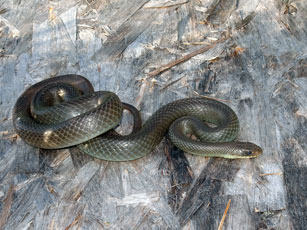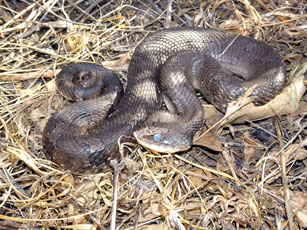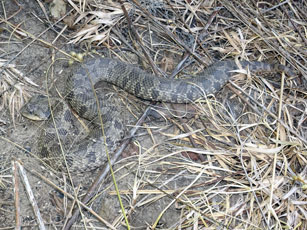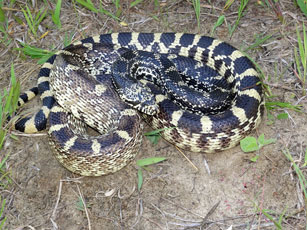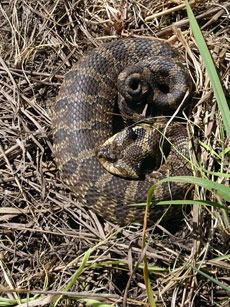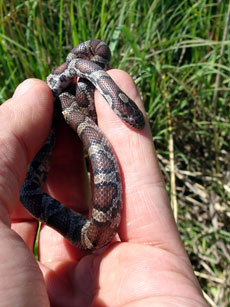
6-10-17
Trip Details
Location: Linn County, Iowa
Weather: 75 degrees early, high of 90. Clear skies, windy.
Time: 7:30 am through 2:30 pm
Herpers: Don Becker and Jim Scharosch
Account by: Jim Scharosch
Photos by: Jim Scharosch
Today we dubbed it the Linn County Quintet. It's along the same lines as the Kansas Lampropeltis Trifecta of finding a milksnake, kingsnake and prairie kingsnake all in the same day. The Linn County Quintet consists of the "big five" snakes of the county, the fox snake, the milksnake, the racer, the bullsnake and the hognose snake all found in one day. Those are listed in the order of difficulty of finding each species in the county from easiest to most difficult, with the bull and the racer probably being interchangeable at three and four. You don't start off the day with the goal of completing the quintet, it sorta sneaks up on you as the day rolls on...
Our goal of the day was actually to set out cover objects in some new survey sites. We planned on getting a bit of herping in because we had sites to check near where the new objects were going out. It was going to be a hot day so Don was to my place by 7:00 am so we could beat the heat as much as possible.
We weren't very far in when we turned up our first snake of the day. It was a young adult Bullsnake (Pituophis catenifer sayi) found under tin.
It was in shed and in no mood to cooperate for photos so I just grabbed a quick shot. I'm sure this was the same snake I found under this same tin last week.
We circled around and checked some boards and turned up an adult Racer (Coluber constrictor).
It was the first adult racer I had seen this year. They are a fairly common species in the area, I just haven't seen a lot of them this year for some odd reason.
As we were driving to the next site we saw some motion on the road behind us. It looked like two blackbirds fighting on the ground on first glance, but we soon realized it was a weasel chasing a young rabbit. The rabbit ran up the road and then doubled back on the weasel. The weasel spun around and chased the rabbit for five feet and then caught up to it and grabbed it and drug it off into the brush. We were in the truck yelling "Get it!" and "Go Weasel!". It was pretty cool. You see some neat non-herp stuff when you are out herping!
We moved to another site where Don had seen hognose snakes a few times this spring. Don basically called which tin we would see one, and he was right. The tin held a small adult Eastern Hognose Snake (Heterodon platirhinos).
It was in shed as you can tell from the blue eye color. It never played dead or got very worked up. We grabbed a few photos and left it alone.
Don called the next tin that he thought would have a hog, and of course it did.
This one was roughly the same size as the first. The number of hogs that have been found at these survey sites is fairly impressive. It's nice to have a spot to go and have a reasonable chance of seeing one.
We drove around and laid out our cover objects for future survey sites. It had warmed up a bit and we thought it might be interesting to see if anythng new had moved up under the tin we had checked earlier in the morning. Don flipped this really bright high contrast bullsnake under one of the tins.
It was a four foot plus snake and was almost uniformly black in coloration, lacking the transition to brown blotches that is more common in Iowa bulls.
That closed out our finds at this location. We had three of the snakes in the Linn County Quintet, and they were the three more difficult species to find. Even with that, we had no thoughts of trying to complete the quintet. As we headed out, I suggested we stop off at a survey site that we had laid out over a year ago and had only checked once. It wasn't a great site, it was in kinda marginal habitat and it was a long drive in to get to it. It was also starting to get a lot hotter. This was a board site instead of a tin site, so that was a plus. We decided to try it. As we were getting out of the truck at the site, we were discussing what we thought might turn up here and during the course of the conversation Don mentioned that he wouldn't expect to see hogs here. I said something to the effect of "It wouldn't surprise me".
It was worth the effort, because under the second board we checked we saw a patch of scales in the grass. We both thought "fox snake" in our heads. All I said was, "Cool, look..." then I said, "Hey, that's a hog" and sure enough it was. It tried to dive down a hole that it was sitting right next to, so I grabbed it up.
This one was a little more yellowish than the first two and you can see from the coloration in the photo how just seeing a few inches of the dorsal pattern why it could be mistaken at first glance for a fox snake. Don also noticed that there was a juvenile Milksnake (Lampropeltis triangulum) cruising through the grass under the board.
It was in shed and pretty dinged up so I just took a quick in hand shot. As we were driving out, Don mentioned that now we had four of the five species of "big snakes" from Linn County. We kicked names around and came up with the Linn County Quintet and after laughing about it for a bit decided that we had to give it a try. It was getting hot out but all we had left to find was a fox snake, arguably the easiest of the five to find even with the heat. We hit a number of different sites that have turned up fox snakes in the past, and a few that hadn't. We hit seven sites in all and struck out. We only had one more site to try, and it was a site that only had tin. There were a few pieces in the shade and those would really be our only chance. As luck would have it, under one of the three pieces of tin in the shade, there was a young Fox Snake (Pantherophis vulpinis) that had just had a large meal.
That meal was probably the only reason that snake was sitting under that warm tin. The extra heat would aid in him digesting that large meal.
So that was it, we pulled off the Linn County Quintet on a hot day in June! It was a fun day. We laid out some new sites, found a hog at a site where we hadn't seen them before and nabbed all five big snake species in the county in one day.


